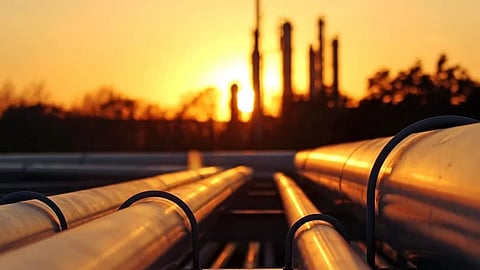

New Delhi: The government has lowered the ceiling price that Reliance Industries and partner BP Plc, as well as other operators, can charge for natural gas produced from deepwater and other difficult fields. According to a notification issued by the Petroleum Planning and Analysis Cell (PPAC), the ceiling price for gas from deepwater, ultra-deepwater and high pressure-high temperature (HPHT) discoveries has been reduced to USD 9.72 per million British thermal unit (MMBtu) on gross calorific value basis for the six-month period from October 1, 2025 to March 31, 2026
Follow Energy Watch on X
This is about three percent lower than the previous ceiling of USD 10.04 per MMBtu applicable for April to September 2025. The ceiling is reviewed twice a year, on April 1 and October 1.
In a separate notification, PPAC said the price of natural gas from legacy fields — also known as APM gas — produced by ONGC and Oil India from nomination fields, has been notified at USD 6.96 per MMBtu for October 2025, but remains capped at USD 6.75 per MMBtu under the ceiling mechanism.
This gas is the key input used by city gas distributors for supplying compressed natural gas (CNG) and piped natural gas (PNG) to households, as well as for producing fertilisers and electricity. Together, the CNG and residential PNG segments account for around 60 percent of city gas sales.
India operates under two separate pricing frameworks. The first is for gas from nomination or legacy fields of ONGC and OIL, where the price is linked to crude oil but subject to a government-notified floor of USD 4 and a ceiling of USD 6.75 per MMBtu. The second is for gas from difficult-to-develop areas such as deepsea and HPHT fields, where producers have pricing freedom but are subject to a ceiling that is revised every six months.
The downward revision of the ceiling price for difficult fields, which include Reliance and BP’s deepwater assets in the KG-D6 block, comes at a time when domestic demand for gas is rising but international prices have softened. For consumers, the continuation of the cap on APM gas at USD 6.75 ensures stable input costs for CNG and PNG segments, as well as for fertiliser and power producers.
Follow Energy Watch on LinkedIN
However, the reduction in the ceiling price may affect revenue realisation for producers operating in deepsea fields, where development costs are significantly higher than those for onshore or shallow-water projects. The government has sought to balance affordability for consumers with incentives for upstream investment by retaining a two-tiered pricing system.
